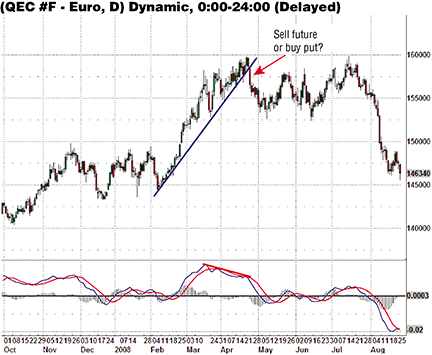OPTIONS
What, When, And Why
Options On Futures
Here’s how to identify the appropriate underlying conditions and timing for option strategies.
The first two things industry insiders will tell you about options on futures is that more than 80% of them expire worthless, and that selling naked options on a monthly basis is frequently referred to as “picking up dimes in front of a steamroller.” Put those together and you get losses more often than not if you buy them or you get paid a meager sum on a regular basis if you sell them, and hope you figure out a better way quickly before you get crushed by the steamroller. Trading futures and options on futures carries a substantial risk of loss and is not suitable for every investor. As with any type of investment, you have to do your homework and understand the risks.
Drive the steamroller
In my opinion, the “better” way is to use options in conjunction with the opposite position in the underlying futures contract, or when a market is starting to experience a long-term trend shift and an attractive risk/reward ratio justifies the possibility of a small loss. These strategies can mean you still sweep up those dimes but you don’t have to worry about the steamroller or, even better, set yourself up to drive the steamroller.
Before we get into option strategies that might apply to setups and situations in the markets you follow, we need to define the basic instruments and terms used. An option is a derivative product of a security, commodity, or other financial product that allows the holder or buyer the right to control the underlying product at a specific price at a future date. Once that date passes, the option is either exercised, meaning that the option holder takes control of the asset because price is beyond the price specified in the option, or the option expires worthless because the price did not reach the point specified in the option. Over the course of its life, the option will fluctuate in price, as will the price of the underlying product.
Options defined
Call option: The right to go long a market at a specific price (the strike price) at a specific time (option expiration). A buyer of a call option only risks what he paid for the option, while his potential profit is only limited by how far the market can rally, which theoretically is unlimited. As a seller of a call option, the trader’s profit is limited to the price at which he sold the option, while the risk is unlimited. When you buy an option, your futures account is debited for the cost of the option, meaning the full cash cost of the option is removed from your account, until you offset the position.

Figure 1: PROTECT YOURSELF AGAINST FURTHER PRICE ADVANCEMENT. On this daily chart of the euro, you can see that it took a few months to rally to 160. You could have sold a futures contract and sold a 150 put one month out. You could also place a buy-stop on the futures trade above 160.00.
Put option: The right to go short a market at a specific price (the strike price) at a specific time (option expiration). A buyer of a put option only risks what he or she paid for it, while the potential profit is only limited to how far the market can fall, which theoretically is to zero. The seller of a put’s profit is limited to the price sold, while the risk is theoretically from the current underlying price down to zero. When you sell an option, your futures account is credited with the cash amount you sold it at until you offset the option.